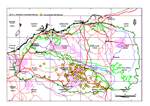Click on images
to enlarge


, BRM 14 July 2000_sml.jpg)
Photographer: B.R. Maslin
, Joffre Falls, BRM 16 July 2000_sml.jpg)
Photographer: B.R. Maslin

Photographer: B.R. Maslin
, Hamersley Ra, BRM 16 July 2000, ORIGINAL SCAN, ADJUSTED RICHARD WOODMAN_sml.jpg)
Photographer: B.R. Maslin

Spindly variant. Photographer: B.R. Maslin

Photographer: M.W. McDonald

Photographer: B.R. Maslin
, BRM 8066, ORIGINAL SCAN, ADJUSTED RICHARD WOODMAN_sml.jpg)
Photographer: B.R. Maslin

Photographer: B.R. Maslin

Photographer: J. Maslin
, LSWE 7030, lab photo by Fiona McCallum ADJUSTED_sml.jpg)
Seed from one herbarium voucher. Scale in mm. Photographer: F. McCallum.
Botanical name
Acacia hamersleyensis Maslin, Nuytsia 4: 90, figs 8 & 11 (1982)
Common name
Karijini Wattle (preferred common name) and Hamersley Range Wattle
Description
Spreading, bushy or openly branched, rounded or obconic shrubs or trees 2-4 m high with up to six main stems from ground level, oldest plants sometimes having a somewhat gnarled with spreading growth, sometimes a wispy, spindly shrub to 5 m tall with one or few erect stems and a sparse open crown. Bark dark brown to grey or black, smooth except longitudinally fissured and fibrous on main stems (particularly at base) of mature plants. Branchlets glabrous, yellowish to light brown or orange at extremities, sometimes pruinose. New shoots light green and invested with a pale citron-sericeous (or occasionally silvery white) indumentum when very young, aging glabrous and pale green. Phyllodes narrowly elliptic, slightly asymmetric with upper margin more convex than lower, normally 8-14 cm long and 7-17 (-25) mm wide, sometimes to 20 cm long and 4-5 mm wide on the wispy variant, a few specimens have consistently short phyllodes (5-7 cm), coriaceous, spreading, straight or shallowly falcate, glabrous, glaucous to sub-glaucous; parallel longitudinal nerves numerous, fine, close, not anastomosing, 1-3 nerves slightly more prominent than the rest; apex acuminate, innocuous; pulvinus orange or yellow, mostly (4-) 5-10 mm long, wrinkled when dry. Inflorescences simple but sometimes falsely racemose at ends of branchlets due to phyllode reduction; peduncles short (3-7 mm long), thick, sparsely hairy; spikes showy, fragrant, large (3-6.5 cm long and 6-8 mm in diameter when dry), bright golden, flowers close together to form a dense spike. Flowers 5-merous; sepals 1/3-2/3-united, the calyx tube white-hairy. Pods narrowly oblong, 2.5-8.5 cm long, 5-8 mm wide, firmly chartaceous, slightly undulate, straight to irregularly shallowly curved, invested with short, light golden and silvery white spreading hairs, light brown. Seeds oblique in the pods, obloid to ellipsoid, 4-4.5 mm long, 2.5-3 mm wide, slightly shiny to glossy, brown to grey-brown; areole surrounded by a band of dull yellow tissue; aril cream coloured (pale yellowish when dry).
Characteristic features
Spreading, bushy, multi-stemmed shrubs or trees, sometimes wispy, spindly and single or few-stemmed. Branchlets glabrous. New shoots with a pale citron-sericeous indumentum when very young. Phyllodes narrowly elliptic, somewhat large (mostly 8-14 cm x 7-17 mm), coriaceous, glaucous to sub-glaucous, glabrous, parallel longitudinal nerves numerous, fine and close together, apices acuminate, innocuous; pulvinus orange, long (mostly 5-10 mm). Inflorescences simple; peduncles short (3-7 mm) and thick, sparsely hairy; spikes large (3-6.5 cm x 6-8 mm when dry), bright golden, showy, densely flowered. Pods narrowly oblong, firmly chartaceous, slightly undulate, invested with short, wide-spreading, light golden and silvery white hairs. Seeds oblique in the pods; areole surrounded by a band of dull yellow tissue.
Distribution and ecology
Mostly restricted to Pilbara region in northwest Western Australia where it occurs in the Hamersley Range from near Newman west to near Wittenoom, Paraburdoo and Mt Wall (west of Tom Price); there is an outlier at Serpens Glen in the Carnarvon Range in the Little Sandy Desert. Grows in often skeletal, iron-rich soils over massive banded ironstone on ridges and upper slopes of ranges, on scree slopes and in rocky gullies. It sometimes forms groves along watercourses descending from ranges.
Flowering and fruiting period
Flowers from June to September with the main flush in July and August. Pods with mature seeds have been collected in October and November.
Variation
Normally grows as multi-stemmed bushy shrubs but sometimes as single or few-stemmed spindly shrubs with an open wispy growth form. The taxonomic status of this spindly variant needs to be further investigated. Phyllode size variation is noted in the description above.
Affinities
Related to, and until recently confused with A. bromilowiana (see that species for distinguishing features). May superficially resemble A. citrinoviridis, A. fecunda, A. tumida var. pilbarensis and A. xiphophylla (see those species for distinguishing features). In most populations of the presumed hybrid species, A. daweana , it is likely that A. hamersleyensis is one of the presumed parents.
Conservation status
Not considered rare or endangered.
Origin of name
The botanical name is in reference to the species geographic distribution which is largely (but not exclusively) confined to the Hamersley Range. The preferred common name Karijini Wattle (also spelt Garijini) is from the Banyjima indigenous language and refers to the Hamersley Range (Wangka Maya 2001). The name Karijini is also currently used for Western Australia's second large national park, Karijini National Park, which was formerly known as Hamersley Range National Park.
